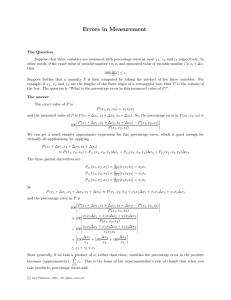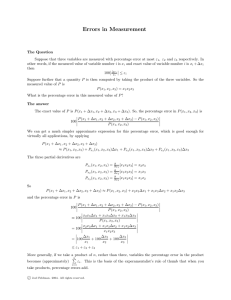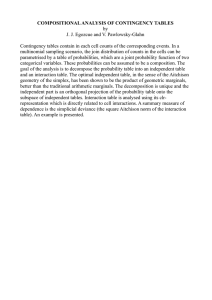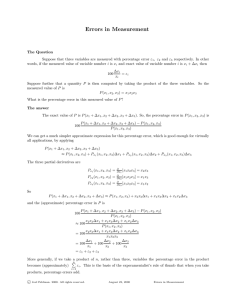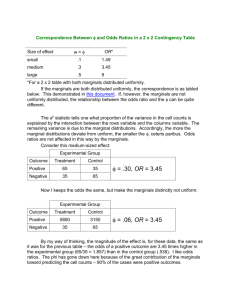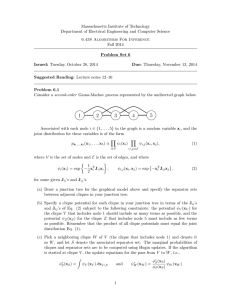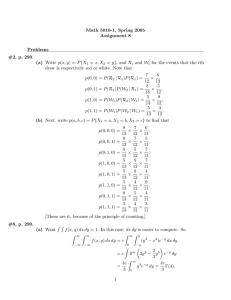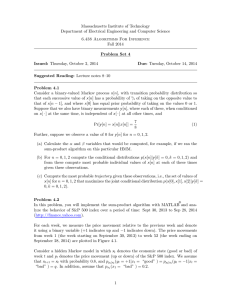Document 13512707
advertisement
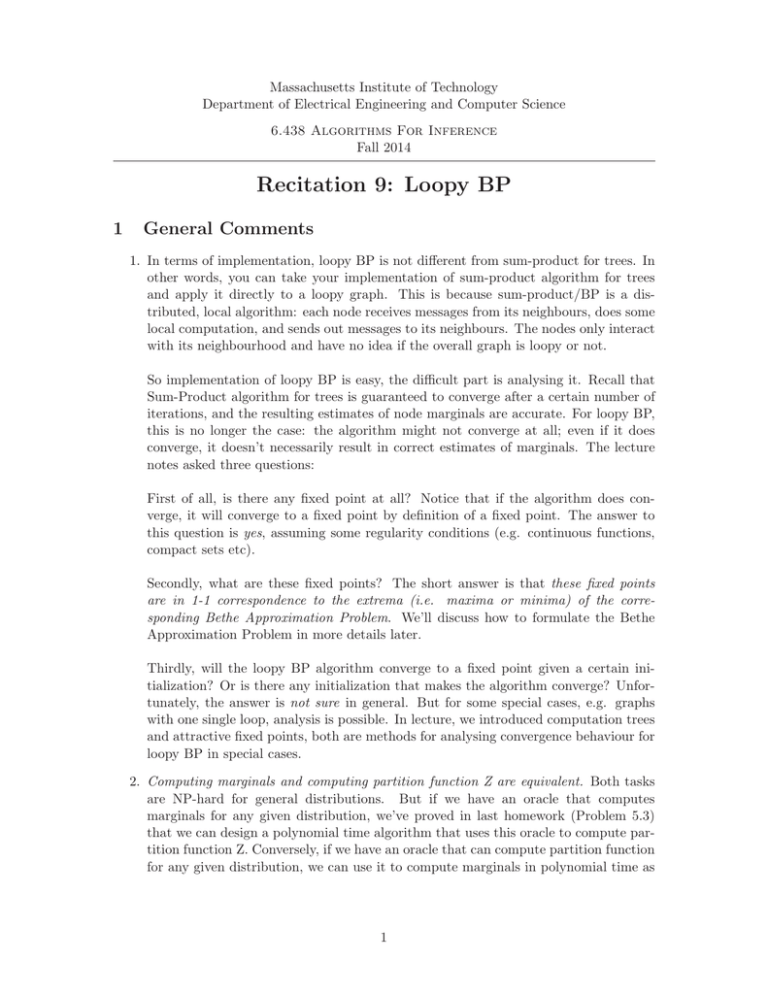
Massachusetts Institute of Technology
Department of Electrical Engineering and Computer Science
6.438 Algorithms For Inference
Fall 2014
Recitation 9: Loopy BP
1
General Comments
1. In terms of implementation, loopy BP is not different from sum-product for trees. In
other words, you can take your implementation of sum-product algorithm for trees
and apply it directly to a loopy graph. This is because sum-product/BP is a dis­
tributed, local algorithm: each node receives messages from its neighbours, does some
local computation, and sends out messages to its neighbours. The nodes only interact
with its neighbourhood and have no idea if the overall graph is loopy or not.
So implementation of loopy BP is easy, the difficult part is analysing it. Recall that
Sum-Product algorithm for trees is guaranteed to converge after a certain number of
iterations, and the resulting estimates of node marginals are accurate. For loopy BP,
this is no longer the case: the algorithm might not converge at all; even if it does
converge, it doesn’t necessarily result in correct estimates of marginals. The lecture
notes asked three questions:
First of all, is there any fixed point at all? Notice that if the algorithm does con­
verge, it will converge to a fixed point by definition of a fixed point. The answer to
this question is yes, assuming some regularity conditions (e.g. continuous functions,
compact sets etc).
Secondly, what are these fixed points? The short answer is that these fixed points
are in 1-1 correspondence to the extrema (i.e. maxima or minima) of the corre­
sponding Bethe Approximation Problem. We’ll discuss how to formulate the Bethe
Approximation Problem in more details later.
Thirdly, will the loopy BP algorithm converge to a fixed point given a certain ini­
tialization? Or is there any initialization that makes the algorithm converge? Unfor­
tunately, the answer is not sure in general. But for some special cases, e.g. graphs
with one single loop, analysis is possible. In lecture, we introduced computation trees
and attractive fixed points, both are methods for analysing convergence behaviour for
loopy BP in special cases.
2. Computing marginals and computing partition function Z are equivalent. Both tasks
are NP-hard for general distributions. But if we have an oracle that computes
marginals for any given distribution, we’ve proved in last homework (Problem 5.3)
that we can design a polynomial time algorithm that uses this oracle to compute par­
tition function Z. Conversely, if we have an oracle that can compute partition function
for any given distribution, we can use it to compute marginals in polynomial time as
1
well. Consider a distribution px (x), notice
px (x1 , ..., xn ) =
px1 (x1 ) =
x2 ,...,xn
and
∗
�px (x1∗,...,xn )
px (x1 ,...,xn )
x2 ,...,xn
compute Z and
L
1
Z
x2 ,...,xn
p∗x (x1 , ..., xn )
is a distribution over variables x2 , ..., xn . Thus the oracle can
x2 ,...,xn
p∗x (x1 , ..., xn ) for us, and we can get the marginal distribution
over x1 in polynomial time.
In inference, marginal distributions usually make more sense. But in statistical physics
community, where a large body of work on loopy BP algorithm comes from, log par­
tition function is very important. In fact, many quantities, e.g. free energy, free
entropy, internal energy etc, are defined in terms of log(Z).
2
2.1
Details
Variational Characterization of log(Z)
Remember our original goal is to compute log(Z) for a given distribution px (x). However,
we will convert the problem into an equivalent optimization problem
log(Z) = sup F (μ)
μ∈M
where M is the set of all distributions over x. We’ll define F (μ) and derive the conversion
in a minute but there is a fancy term for converting a computation problem into an opti­
mization problem: ’variational characterization’.
Let us first re-write px (x) as px (x) = Z1 exp(−E(x)). Given any distribution, you can
always re-write it in this form (known as Boltzmann Distribution) by choosing the right
E(x). E(x) has a physical meaning. If we think of each configuration x as a state, E(x) is
the energy corresponding to the state. The distribution indicates that a system is less likely
to be in a state that has higher energy. Taking log on both sides and rearrange, we get
E(x) = −log(px (x)) − log(Z)
Now we define Bethe free entropy F (μ) as
F (μ) = −
μ(x)log(μ(x)) −
x∈XN
μ(x)E(x)
x∈XN
2
Notice the first term is the entropy of distribution μ(x) and the second term is the average
energy with respect to distribution μ(x). Replace E(x) with px (x) and log(Z), we get
X
X
F (μ) = −
μ(x)log(μ(x)) −
μ(x)E(x)
x∈XN
=−
X
x∈XN
x∈XN
=−
X
X
μ(x)log(μ(x)) +
μ(x)(log(px (x)) + log(Z))
x∈XN
X
μ(x)log(μ(x)) +
x∈XN
μ(x)log(px (x)) + log(Z)
x∈XN
= −D(μ(x)||px (x)) + log(Z)
where D(·||·) is the KL-divergence and thus always non-negative.
∴ log(Z) ≤ F (μ) and equality is achieved if and only if μ(x) = px (x)
∴ log(Z) = sup F (μ)
μ∈M
Notice this optimization problem is still NP-hard for general distributions. It can be made
computationally tractable if we’re willing to optimize over a different set instead of M. For
instance, the basic idea of mean field approximation is to look at a subset of M whose
elements are distributions under which x1 , ..., xn are independent. The resulting log(ZM F )
is a lower bound of the actual log(Z). In Bethe approximation problem, we maximize F (μ)
ˆ that is neither a subset nor a superset of M. We will discuss M
ˆ in more details
over a set M
in next section.
2.2
Locally Consistent Marginals
Recall that a distribution px (x) can be factorized in the form
px (x) = (
�
�
pxi (xi ))(
i∈V
(i,j)∈E
pxi ,xj (xi , xj )
)
pxi (xi )pxj (xj )
if and only if the distribution factorizes according to a tree graph.
The main idea of Bethe Approximation is instead of optimizing over the set of all dis­
ˆ which is defined as:
tributions M, we optimize F (μ) over M,
M̂ = {μx (x) = (
�
μxi (xi ))(
i∈V
�
(i,j)∈E
μxi ,xj (xi , xj )
)}
μxi (xi )μxj (xj )
where {μxi (xi )}i∈V and {μxi ,xj (xi , xj )}(i,j)∈E are a set of locally consistent marginals, in other
words:
3
μxi (xi ) ≥ 0, ∀xi
μxi ,xj (xi , xj ) ≥ 0, ∀xi , xj
X
μxi (xi ) = 1, ∀i
xi
X
μxi ,xj (xi , xj ) = μxj (xj )
xi
X
μxi ,xj (xi , xj ) = μxi (xi )
xj
ˆ is neither a superset nor a subset of M, thus log(ZBethe ) is
In lecture, we discussed that M
neither an upper bound nor a lower bound on log(Z).
ˆ Consider a distribution that factorizes
1. There are elements in M that are not in M.
according to a loopy graph.
ˆ that are not in M. Check out the following example.
2. There are elements in M
4
It is easy to check that the {μxi (xi )}i∈V and {μxi ,xj (xi , xj )}(i,j)∈E are a set of locally consis­
tent marginals. We claim they do not correspond to any actual distribution. Let us assume
that they are the local marginals computed from some distribution qx1 ,x2 ,x3 . Then we have
q(0, 0, 0) + q(0, 1, 0) = μ13 (0, 0) = 0.01
q(0, 0, 1) + q(1, 0, 1) = μ23 (0, 1) = 0.01
q(0, 0, 0) + q(0, 0, 1) = μ12 (0, 0) = 0.49
Since q is a distribution, all qx1 ,x2 ,x3 terms are non-negative. Thus the first two equations
indicate q(0, 0, 0) ≤ 0.01 and q(0, 0, 1) ≤ 0.01. So the third equation cannot hold.
∴ The assumption is false and the set of locally consistent marginals does not correspond
to any actual distribution.
2.3
Computation Trees
As mentioned before, computation tree is a method to analyse behaviour of Loopy BP in
special cases such as graphs with a single loop. In this section, we will look at an example to
get an idea how this method can be applied. Consider the graph below, and its computation
tree rooted at node 1 and run for 4 iterations.
1
1
Ψ12
2
4
3
3
2
(2)
Ψ14
4
Ψ23
(2)
4
Ψ23
(2)
1
3
Figure 1: Original Graph
(2)
2
(3)
1
Figure 2: Computation Tree Rooted at
Node 1, for 4 Iterations
5
Notice the messages satisfy the following equations:
(t)
m2→1 (0)
(t)
m2→1 (1)
=
ψ23 (0, 0) ψ23 (1, 0)
ψ23 (0, 1) ψ23 (1, 1)
=
ψ34 (0, 0) ψ34 (1, 0)
ψ34 (0, 1) ψ34 (1, 1)
=
ψ14 (0, 0) ψ14 (0, 1)
ψ14 (1, 0) ψ14 (1, 1)
=
ψ12 (0, 0) ψ12 (1, 0)
ψ12 (0, 1) ψ12 (1, 1)
(t−1)
m3→2 (0)
(t−1)
m3→2 (1)
(t−2)
m4→3 (0)
(t−2)
m4→3 (1)
(t−3)
m1→4 (0)
(t−3)
m1→4 (1)
∴
(t)
m2→1 (0)
(t)
m2→1 (1)
)
)
)
)
= A23 A34 AT14 A12
(t−1)
m3→2 (0)
(t−1)
m3→2 (1)
(t−2)
m4→3 (0)
(t−2)
m4→3 (1)
(t−3)
m1→4 (0)
(t−3)
m1→4 (1)
(t−4)
m2→1 (0)
(t−4)
m2→1 (1)
(t−4)
m2→1 (0)
(t−4)
m2→1 (1)
(t−1)
= A23
m3→2 (0)
(t−1)
m3→2 (1)
= A34
m4→3 (0)
(t−2)
m4→3 (1)
= AT14
m1→4 (0)
(t−3)
m1→4 (1)
= A12
m2→1 (0)
(t−4)
m2→1 (1)
=M
(t−2)
(t−3)
(t−4)
(t−4)
m2→1 (0)
(t−4)
m2→1 (1)
In other words, the message from 2 to 1 at iteration t can be written as the product of a
matrix and the message from 2 to 1 at iteration t-4. Thus we have
(4t)
m2→1 (0)
(4t)
m2→1 (1)
= Mt
(0)
m2→1 (0)
(0)
m2→1 (1)
Notice M is a positive matrix (i.e. each entry is positive). Apply Perron-Frobenious theorem, as t → ∞, M t → λk1 v1 uT1 , where λ1 is the largest eigenvalue of M, and v1 and u1
are the right and left eigenvalue of M corresponding to λ1 . Thus message from 2 to 1 will
converge when number of iteration goes to infinity.
Due to the symmetry of the graph, similar arguments can be made for messages along
other edges as well. So we have proved Loopy BP will converge on this graph.
2.4
Intuition: When Should We Expect Loopy BP to Work Well
Since Sum-Product is a distributed algorithm and it’s exact on trees, intuitively we expect
loopy BP to work well on graphs that are locally tree-like. In other words, if for any node,
its neighbours are ’far apart’ in the graph, we can think of the incoming messages as roughly
independent (recall that incoming messages to each node are independent if and only if the
graph is a tree). On the other hand, if a graph contains small loops, the messages around
the loop will be amplified and result in marginal estimates very different from the true
marginals. The numerical examples below hopefully will provide some intuition.
6
Ψ1(0) = 0.7
Ψ1(1) = 0.3
1
Ψ12(0,0) = Ψ12(1,1) = 0.9
Ψ12(0,1) = Ψ12(1,0) = 0.1
Exact Marginals
Loopy BP Estimated
Marginals
[Px1(0), Px1(1)]
[0.7, 0.3]
[0.9555, 0.0445]
[Px2(0), Px2(1)]
[0.6905, 0.3095]
[0.8829, 0.1171]
[Px3(0), Px3(1)]
[0.6905, 0.3095]
[0.8829, 0.1171]
Exact Marginals
Loopy BP Estimated
Marginals
[Px1(0), Px1(1)]
[0.7, 0.3]
[0.9027, 0.0973]
[Px2(0), Px2(1)]
[0.6787, 0.3213]
[0.7672, 0.2328]
[Px3(0), Px3(1)]
[0.6663, 0.3337]
[0.7487, 0.2513]
[Px4(0), Px4(1)]
[0.6623, 0.3377]
[0.7427, 0.2573]
[Px5(0), Px5(1)]
[0.6663, 0.3377]
[0.7487, 0.2513]
[Px6(0), Px6(1)]
[0.6787, 0.3213]
[0.7672, 0.2328]
Ψ13(0,0) = Ψ13(1,1) = 0.9
Ψ13(0,1) = Ψ13(1,0) = 0.1
3
2
Ψ23(0,0) = Ψ23(1,1) = 0.9
Ψ23(0,1) = Ψ23(1,0) = 0.1
Ψ1(0) = 0.7
Ψ1(1) = 0.3
1
2
6
5
3
4
Ψij(0,0) = Ψij(1,1) = 0.9
Ψij(0,1) = Ψij(1,0) = 0.1
Notice in both cases, the marginals estimated from Loopy BP algorithm is higher than
the exact marginals. In loops, the incoming messages to a node are not independent. But
the Loopy BP algorithm doesn’t know that and still treat them as independent. Thus the
messages will be counted more than once and result in an ’amplification’ effect. Also no­
tice that the ’amplification’ is less severe for size-6 loop, because it is more ’locally tree-like’.
7
What Loopy BP dislikes more than small loops is closely-tied small loops. The follow­
ing example hopefully explain this point pretty clearly.
Ψ1(0) = 0.51
Ψ1(1) = 0.49
1
4
7
2
5
8
3
6
9
Exact Marginals
Loopy BP Estimated
Marginals
[Px1(0), Px1(1)]
[0.5100, 0.4900]
[0.9817, 0.0183]
[Px2(0), Px2(1)]
[0.5096, 0.4904]
[0.9931, 0.0069]
[Px3(0), Px3(1)]
[0.5093, 0.4907]
[0.9811, 0.0189]
[Px4(0), Px4(1)]
[0.5096, 0.4904]
[0.9931, 0.0069]
[Px5(0), Px5(1)]
[0.5096, 0.4904]
[0.9992, 0.0008]
[Px6(0), Px6(1)]
[0.5095, 0.4905]
[0.9930, 0.0070]
[Px7(0), Px7(1)]
[0.5093, 0.4907]
[0.9811, 0.0189]
[Px8(0), Px8(1)]
[0.5095, 0.4905]
[0.9930, 0.0070]
[Px9(0), Px9(1)]
[0.5093, 0.4907]
[0.9810, 0.0190]
Ψij(0,0) = Ψij(1,1) = 0.9
Ψij(0,1) = Ψij(1,0) = 0.1
8
MIT OpenCourseWare
http://ocw.mit.edu
6.438 Algorithms for Inference
Fall 2014
For information about citing these materials or our Terms of Use, visit: http://ocw.mit.edu/terms.
